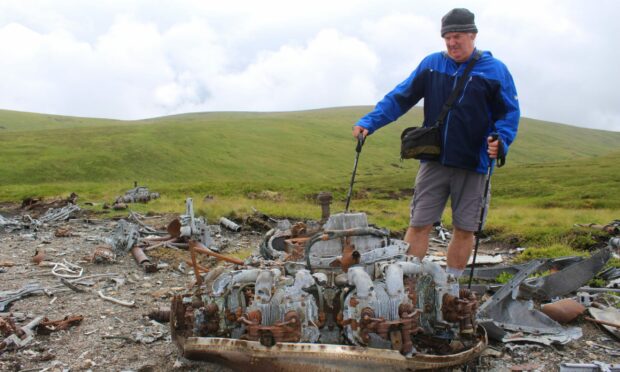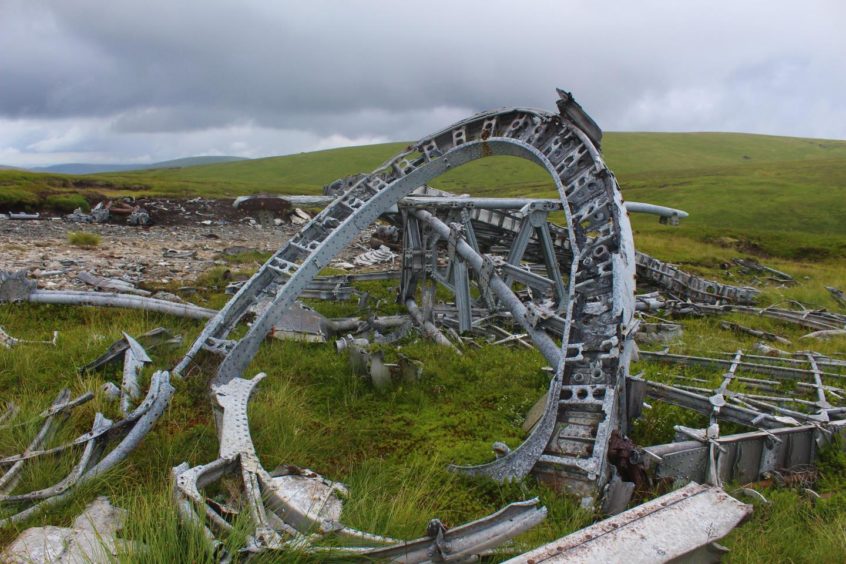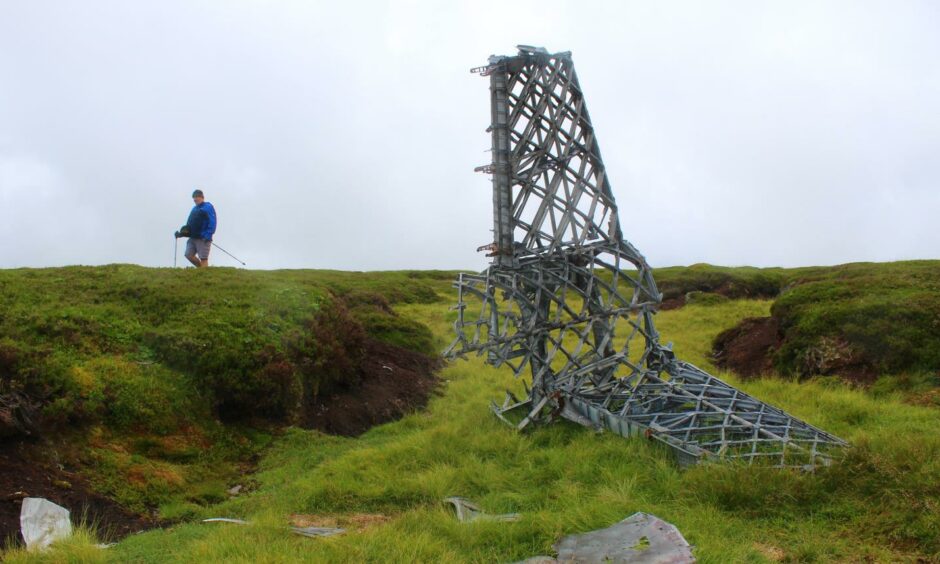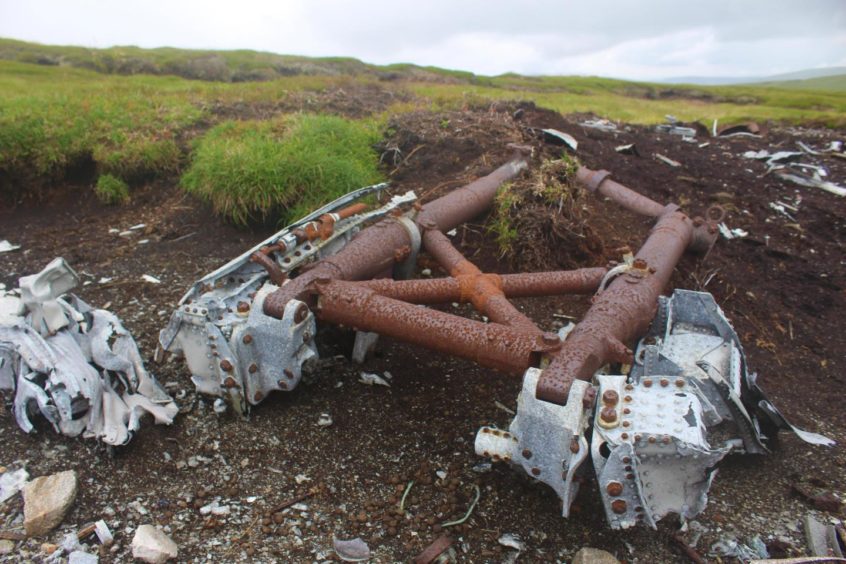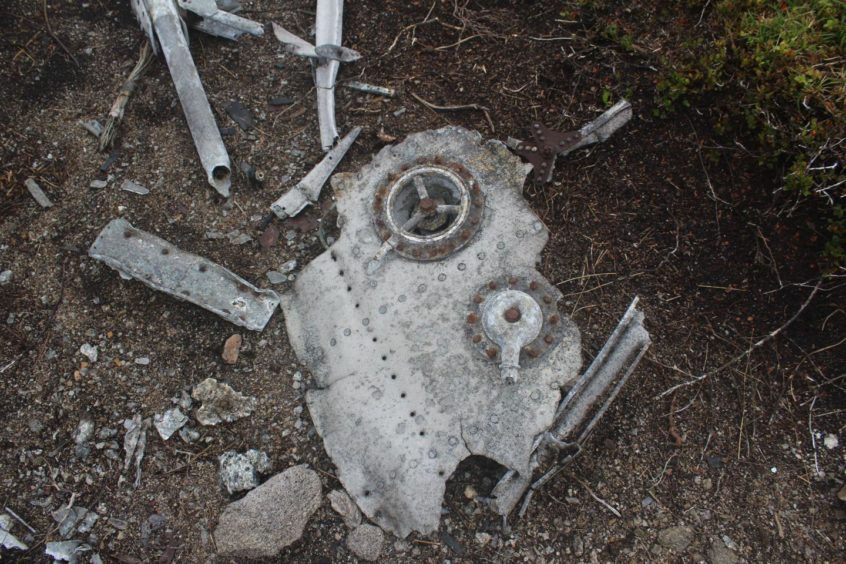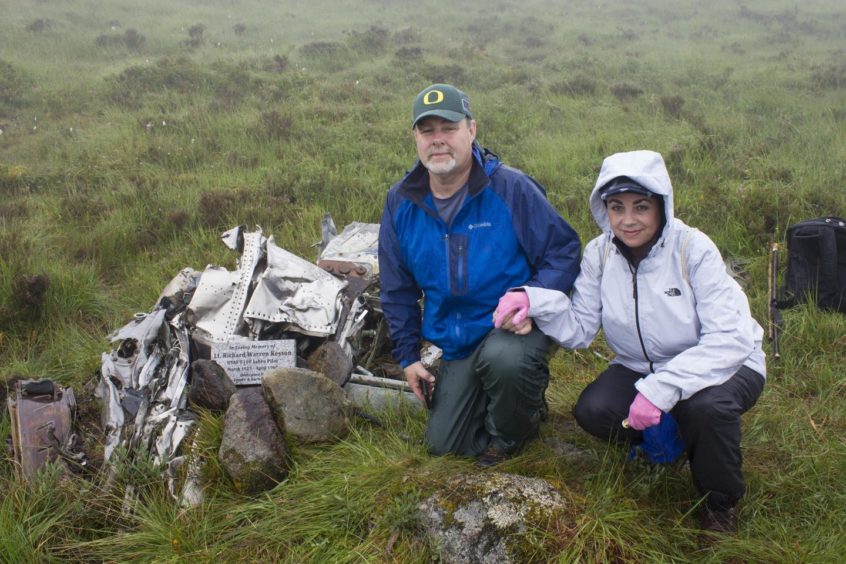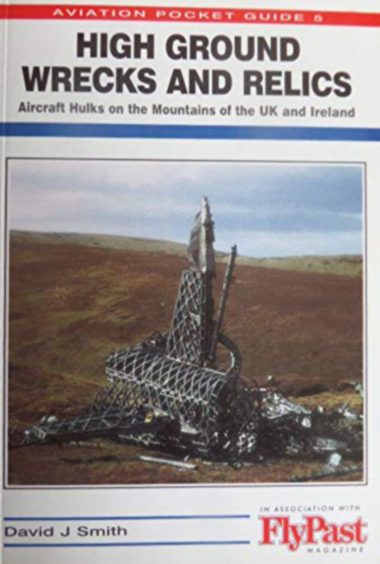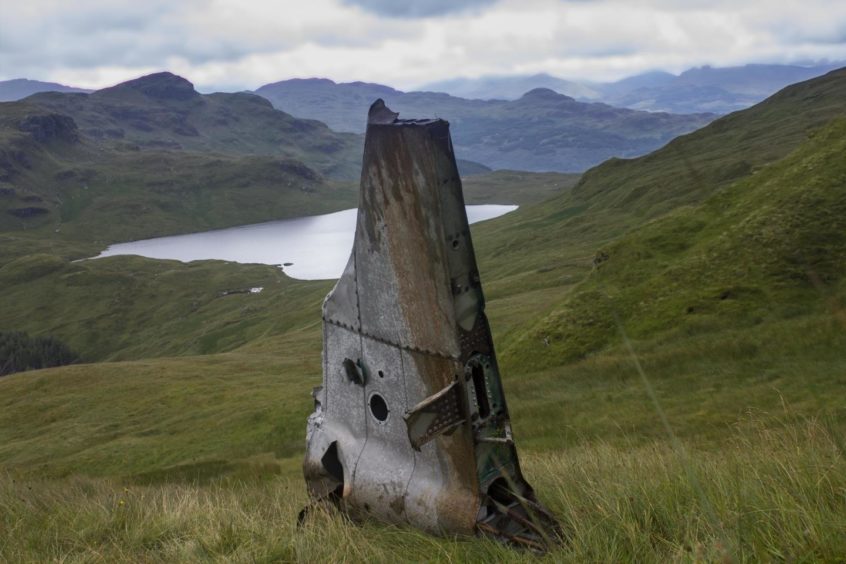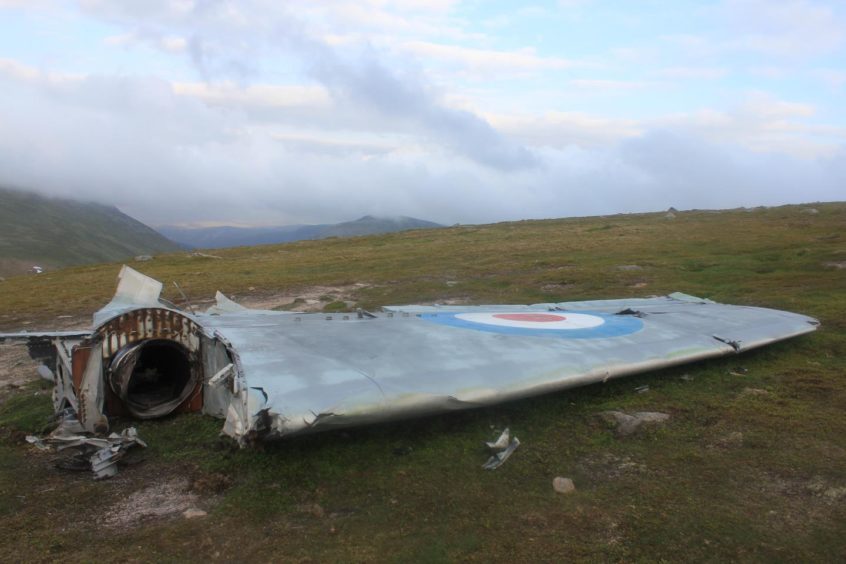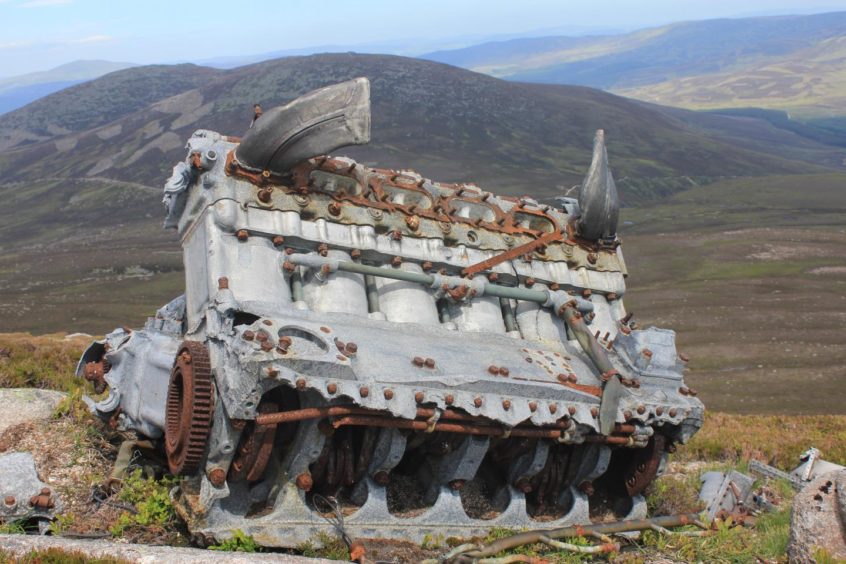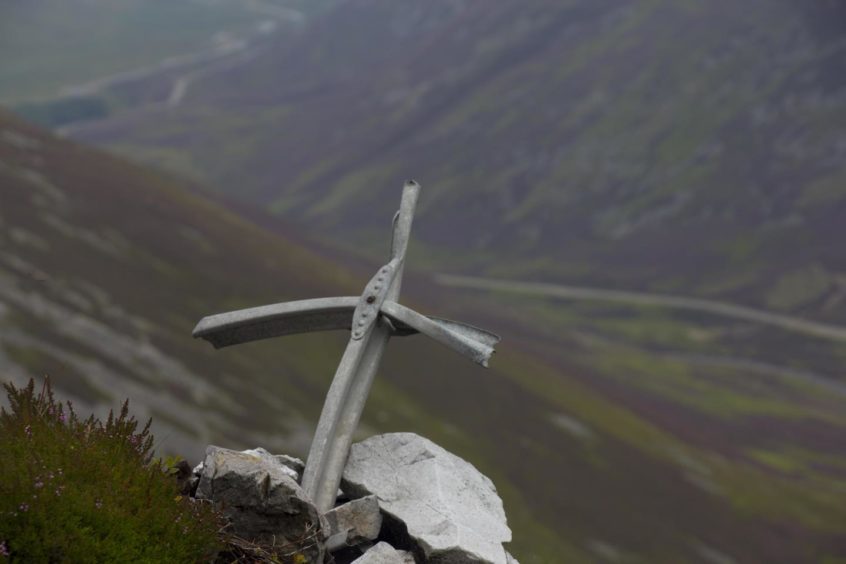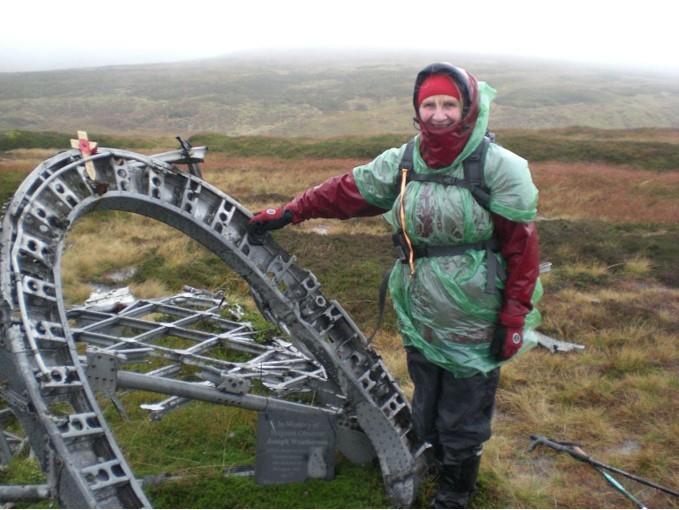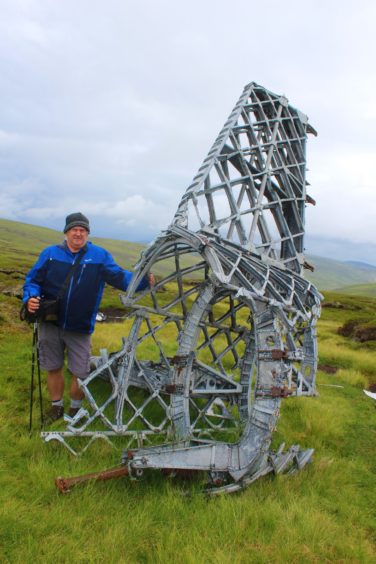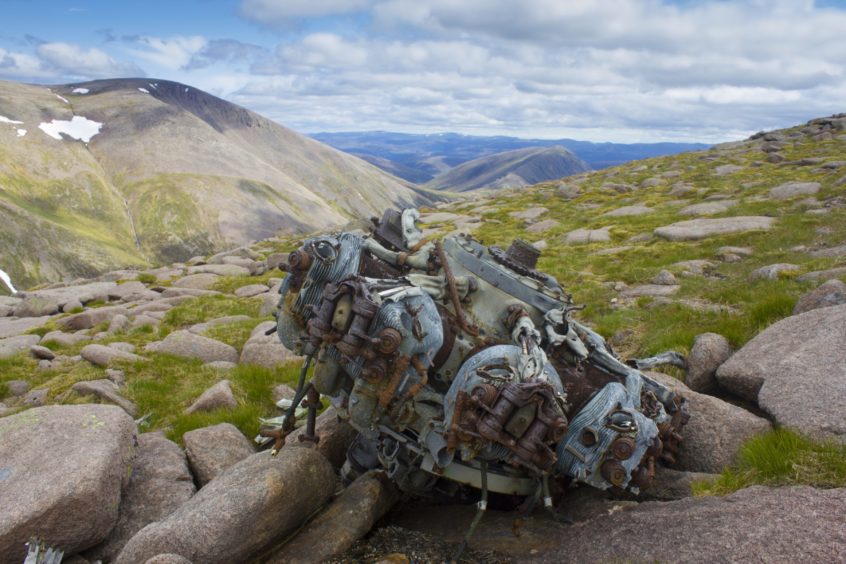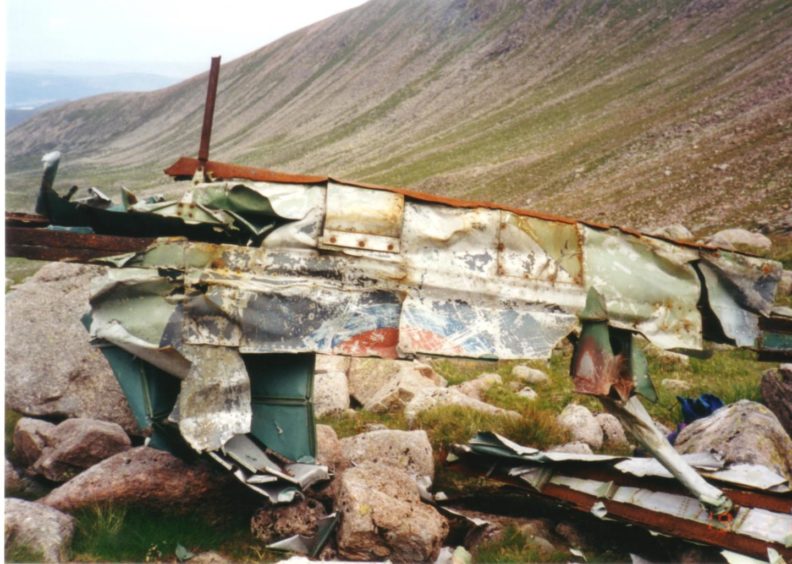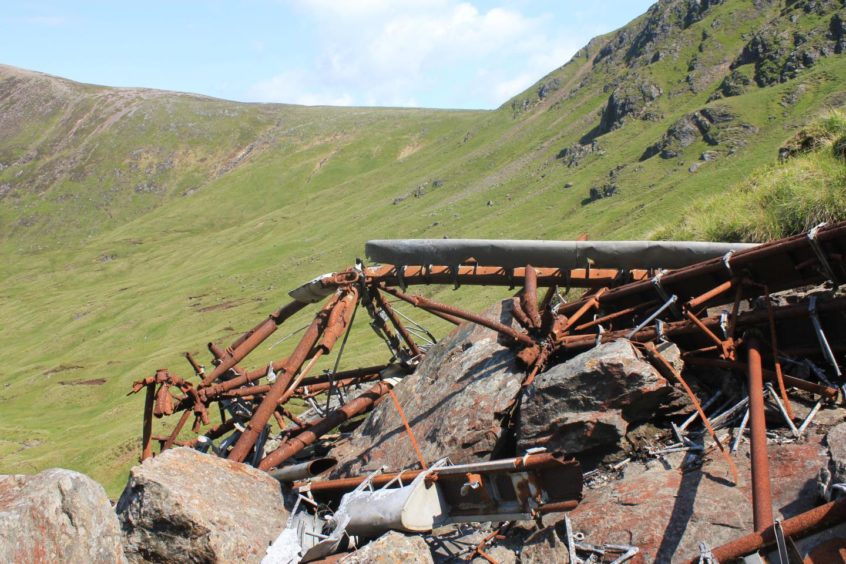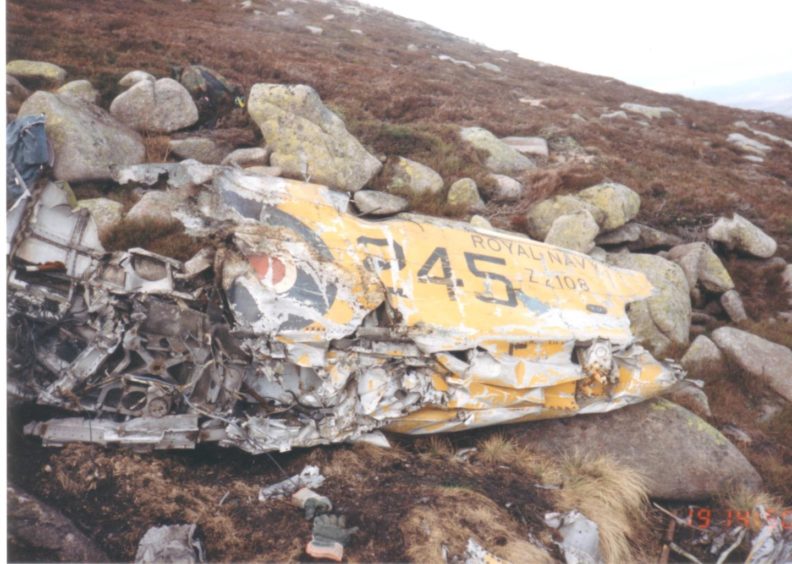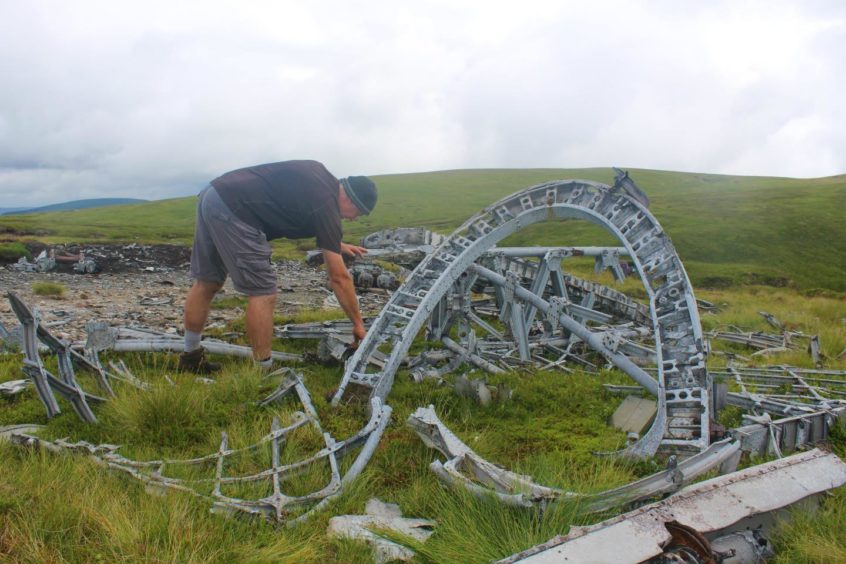The Scottish hills are littered with the remains of crashed aircraft. Gayle Ritchie heads to a site in the Angus Glens with a man who has made wreck hunting his hobby.
A lonely, desolate spot, high in the Angus hills, is the final resting place of a Vickers Wellington bomber that came to grief between Ben Tirran and Muckle Cairn in August 1942.
Almost eighty years on, the skeletal hulk of the crashed aircraft remains scattered across the barren landscape.
Lumps of battered metal are recognisable as engines, wheels, sections of undercarriage, the carcasses of wings and parts of the craft’s fuselage.
The tail section of the bomber lies a few hundred metres away, a largely intact but scarily flimsy metal lattice, sitting forlornly in a patch of boggy ground.
The aircraft was on a training flight from Lossiemouth when part of the cowling came loose, damaging a propeller and causing engine failure.
The pilot attempted a forced landing but the bomber crashed with the loss of four crew.
Remarkably, the tail gunner survived.
Wreck site explorer Gary Nelson has visited the spot in Glen Clova four times and reckons it’s one of the best-preserved in Scotland.
Many are pillaged by souvenir hunters, hungry for a piece of downed aircraft – a slice of military history.
Gary, 57, has explored hundreds of wreck sites across the UK with the vast majority in Scotland.
The Newcastle-based caretaker and bus driver travels up and down the country indulging in his passion, combining it with his love of hillwalking and photography.
While some might think this morbid, in Gary’s mind, what he does is no different from visiting historical battlefields like Culloden, Glencoe or Flodden.
He considers his visits as a kind of tribute; a way of remembering the fallen.
“Initially I have a feeling of satisfaction that my navigation has been good enough to find the spot, but that’s quickly replaced by sadness at what occurred,” he laments.
“I always stand for a minute or so in silence to honour and pay my respects before I leave.”
Gary is not alone in being intrigued by crash sites and their history.
There are networks on social media where “wreck-hunters” share photographs and information on how to find them.
Books have been written on the subject, too. In fact it was the publication in 1997 of the aviation guide High Ground Wrecks and Relics by David J Smith, which charted major mountain crash sites, gave descriptions of remains to be found there and offered grid references, that really spurred Gary on.
Walking into a wilderness shrine
As someone fascinated by the abandoned and derelict, I’m intrigued by Gary’s missions and am delighted when he offers to take me to the Muckle Cairn crash site.
It’s a tough climb up past Loch Wharral, through rough, tussocky terrain and bog until finally we spot the plane glinting in the sun.
As we explore the remains of the bomber, an incongruous and yet strangely compelling sight, I feel a combination of emotions. There’s sadness for the men who lost their lives here. There’s also a sense of awe.
I try to imagine how the tail gunner, the only man to survive the accident, must have felt up here alone.
Stepping over pieces of melted metal strewn across the heathery hillside – from tiny nuts and bolts to engines, wings, exhaust pipes and the arced fuselage frame – I feel slightly sacrilegious. It’s like walking into a wilderness shrine.
I remind myself we’re here to honour the dead. To remember those who might otherwise be forgotten.
I always stand for a minute or so in silence to honour and pay my respects before I leave.”
GARY NELSON
The last time Gary was here was in 2014 with Glynis Symes and Meredith Barnes, the nephew and niece of Sgt Observer Joe Wetherson, one of the crew killed in the crash on August 9 1942 aged 23.
It was Glynis and Meredith’s second visit, the first having been to lay a plaque in 2012 while Gary played a lament on the bagpipes. It was a poignant experience.
Gary was also contacted by the son and daughter of 1st Lt Richard Warren Kesson, the pilot of a plane which crashed in Glen Strae in Argyllshire in 1960. They had seen photos he’d posted of the stricken F100 Super Saber on his website and asked him to take them to the crash site to lay a memorial plaque in 2017.
“Taking relatives to the sites was a massive honour,” he reflects. “It made me feel all the work I’d put into my research was worthwhile.”
Passion for all things aviation
Gary estimates he has visited around 350 crash sites and discovered remains at 278 of them.
His passion for all things aviation was sparked in his boyhood when he spent time plane spotting at his grandparents’ house overlooking Newcastle airport.
Aged 12, he joined the Air Training Corps and started reading the Aviation News. He was fascinated by a feature called Wreckology.
He found one story about someone finding the remains of a De Havilland Mosquito in the Cheviots especially intriguing and set his sights on visiting it one day.
But getting married and having kids meant it wasn’t until 2011 that Gary found the time to truly indulge his passion. His daughter, Heather, had begun competing in national Highland Dancing competitions, most of them in Scotland, and Gary and his wife accompanied her to them all.
“I was sitting in my car outside Aberdeen’s Beach Ballroom waiting for Heather when I decided I needed to find a better way to fill in time,” he recalls.
“After dropping her off at Cumnock the following weekend, I went looking for the remains of a Hawker Hurricane in woods near Loch Doon.
“Heather was at a competition most weekends that summer so I quickly racked up a list of crash sites.”
The majority of crashed aircraft came down during the Second World War and most were left to lie where they fell.
At some sites, like Muckle Cairn, extensive debris can still be found, while souvenir hunters and “recovery groups” have stripped others bare.
“Taking pieces from crash sites is completely unethical,” muses Gary, gazing down at a chunk of melted undercarriage.
“Souvenir hunters don’t care they’re destroying a historical site protected by law. Once an item is removed, it’s no longer in context and simply becomes a piece of scrap metal.
“I never take anything. I have a look around, take photos to record what’s left at these often forgotten sites, pay my respects to any casualties and leave.”
Gary spends hours researching how to locate wreck sites online and via a series of aviation archaeology groups.
He acquired two friends, Stuart Whittaker and Chris Spencer, via his website who often accompany him on expeditions.
“They research locations by contacting landowners, locals, and consulting historical records. Once I have a location to search I work out a route and any access problems.
“If needs be I contact landowners to request permission to visit a site but because of Scotland’s ‘right to roam’ act, that’s not usually necessary other than to find out about stalking or grouse shooting activity.”
Ultimately, Gary sees himself as a “hillwalker with an interest in historical aircraft crash sites”.
“I love being out in remote areas with beautiful scenery and many crash sites are places most people would never think of going because they’re hard to find and completely off the beaten track,” he muses.
“It can be tough locating wrecks. I’ve found myself up to my eyes in bog, scrambling over tussocks, and getting drenched and frozen in the worst Scottish conditions. It takes time and dedication. But finding crash sites makes walks more meaningful as they offer a ‘target’ and navigational challenge while allowing me to see sights not usually seen by the masses.”
For anyone considering following in his footsteps, Gary stresses the importance of being aware of the Protection of Military Remains Act 1986 which states it’s an offence to interfere with the crash site of military aircraft. In essence, don’t remove anything!
Glynis’s experience
As a child, Glynis Symes would visit her Uncle Joe’s grave with her dad on Remembrance Day. She knew he had died in a plane crash in the Angus Glens during the Second World War and dreamed of visiting the site.
When she spotted Gary’s photos of Muckle Cairn online and read about his exploits, she decided to get in touch.
“It turned out he lived nearby and he agreed to take my cousin Meredith and I to visit the site,” says Glynis, 68.
“My mum and I had a stone plaque made to place at the site.”
When the trio began walking up Glen Clova, they encountered “every weather combination possible” and were soon soaked to the bone.
“We got to the site but couldn’t see it for mist, rain and hailstones like Mint Imperials!” recalls Glynis.
“We were about to turn back but then the strangest, eeriest thing happened. The mist cleared and we could see the plane debris on a bank just opposite.
“Gary took out his bagpipes and played my uncle’s favourite tune, Highland Cathedral, as we laid the plaque.
“It’s a beautiful but desolate place. I found it strange that the scar from the crash was still there.”
Glynis and Meredith repeated the walk two years later with Gary and another cousin, Andrew.
“Each time we found it a truly moving experience and we were so pleased we honoured Uncle Joe,” she says.
Preserving remains
Alan Leishman of Dumfries and Galloway Aviation Museum (DGAM) is a researcher for the British Aviation Archaeological Council, the regulatory body that ensures the preservation of aircraft remains.
Over the last 40 years, he and Alan Thomson, also a member of DGAM, have compiled a list of aircraft accidents and names of those killed in Scotland.
“There have been more than 5,000 aircraft accidents in Scotland from 1913 to the present day with more than 3,500 fatalities, not including crew lost at sea and not recovered,” says Alan.
In the 80s, Alan joined an aviation archaeology group to help excavate aircraft remains. The pieces recovered were often in very good condition.
“Being able to touch pieces of aircraft that no longer exist and visiting sites where lives were lost makes it a very humbling experience,” he reflects.
“Most of these aircraft were military aircraft lost during the Second World War and, in some cases, substantial remains were left buried.
“Most crashes occurred near airfields or on hilly ground. Young, inexperienced pilots were given a few hours’ training before active service which resulted in many incidents.”
Alan’s “best” high ground site visit was to a Lancaster near Kingussie in 1994.
“The aircraft had broken up and was spread around the moorland but the radio equipment, engines and camouflage paint was intact,” he recalls.
“Unfortunately, a few years later, so-called collectors stripped items from the wreck and eventually a licence was granted with most of the remains going to a museum near Waddington.”
The best-preserved excavated aircraft Alan visited was Master N7500 that dived into a bog near Dalmellington in August 1940. Luckily the pilot escaped before it crashed.
“We recovered many items including the pilot’s kitbag with his shaving kit, cap and even an orange, all in great condition. The recovered items are on display at Dumfries Aviation Museum.”
The most-publicised recovery Alan’s been involved with was the Spitfire AD540, named Blue Peter, which crashed on Cairnsmore of Carsphairn in the Galloway Hills on May 23 1942 and was found on May 23 1993. The recovery was featured on Blue Peter.
Ask Alan or Gary why they explore crash sites, and their answer is simple – to preserve history.
“We photograph and GPS crash site positions so that they’re not lost,” says Alan.
“Each site has a story and more importantly names of those killed.
“With so many wind farms being built, many sites could be lost but with accurate locations and sites being classed as having historical significance, we can preserve them for future generations.
“While I agree with taking some parts from crash sites in order for them to be reused or for display in an accredited museum (Montrose Air Station Heritage Centre boasts the propeller of the bomber which crashed on Muckle Cairn), I disagree with people taking wreckage as souvenirs.
“The wreckage is a memorial to the crew who perished and marks where these brave airmen lost their lives.”
In 2013, Alan helped recover parts of a Spitfire L1059 which crashed in February 1941 near Slamannan in the Falkirk area, killing pilot Sgt John Silvester.
A memorial service saw the pilot’s brother presented with flying goggles recovered from the dig.
“The family felt humbled, overwhelmed and thankful for the effort we’d put into the recovery and said we helped answer a lot of questions,” says Alan. “It gave them partial closure.”
- See Gary’s website, What To Do While Highland Dancing: Wreckhunting Walks in the Scottish Hills and Mountains, at wtdwhd.co.uk
